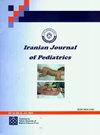Downes Score as a Predictor of Nasal Continuous Positive Airway Pressure Failure in Neonates of 28 - 36 Weeks Gestation with Respiratory Distress: A Survival Analysis
IF 0.4
4区 医学
Q4 PEDIATRICS
引用次数: 0
Abstract
Background: Respiratory distress is the most often encountered problem in preterm infants and the most frequently encountered reason for neonatal intensive care unit (NICU) admission. It can develop into respiratory failure and cause high morbidity and mortality. Noninvasive respiratory support, such as nasal continuous positive airway pressure (NCPAP), was the first line for neonates with respiratory distress. The progression of respiratory distress to respiratory failure in neonates with NCPAP (NCPAP failure) increases the need for mechanical ventilation on the first day of life. With limited resources, clinical observation is critical to predict prognosis and golden time for referral. Downes scores are the accurate and easiest measurement that is used to determine the severity and monitoring of respiratory distress in neonates. However, in Indonesia, there has still been no study that showed an effect of the increment of Downes score in 24 hours and the risk of NCPAP failure. Objectives: This study aimed to measure the association of Downes score at birth, ages 2, 6, 12, and 24 hours, and the risk of NCPAP failure in the first 72 hours using survival analysis. Methods: This prospective observational cohort study included all neonates with 28 - 36 weeks gestation born at Hasan Sadikin General Hospital, Bandung, Indonesia, within March to May 2019, with respiratory distress and NCPAP as respiratory support. Clinical monitoring was conducted using Downes score at birth, 2, 6, 12, and 24 hours of age. The time of NCPAP failure in the first 72 hours was also obtained. Survival analysis with Kaplan-Meier and Cox regression was used to determine the association. Results: This study analyzed 121 neonates at 72 hours with an overall survival rate of 70.2% and a mean survival time of 61.1 hours. Neonates born 28 < 32 weeks and birth weight 1000 - 1499 g had the lowest survival (54.5% and 56.9%). Downes score ≥ 4 at birth and 2 and 6 hours had lower survival than Downes score < 4 (67.7%, 60.5%, and 52.7%). The risk of NCPAP failure in 72 hours was increased with a higher Downes score at 2 hours (hazard ratio [HR] = 1.86 [95% confidence interval [CI]: 1.3 - 2.6, P < 0.001), 6 hours (HR = 1.67 [95% CI: 1.2 - 2.2], P < 0.001). Downes score ≥ 4 at 2 hours (3.26 times, P = 0.030) and 6 hours (2.44 times, P = 0.014) had a high risk of NCPAP failure in 72 hours. Conclusions: The increase in Downes score was associated with a high risk of NCPAP failure at 72 hours of age in preterm neonates with respiratory distress. Two to six hours of monitoring of the Downes score should be considered a critical time for referral.唐氏评分作为呼吸窘迫的 28 - 36 周妊娠新生儿鼻持续正压通气失败的预测指标:生存分析
背景:呼吸窘迫是早产儿最常遇到的问题,也是新生儿重症监护病房(NICU)入院最常见的原因。它可以发展成呼吸衰竭,并导致高发病率和死亡率。无创呼吸支持,如鼻持续气道正压通气(NCPAP),是新生儿呼吸窘迫的首选。新生儿NCPAP的呼吸窘迫进展到呼吸衰竭(NCPAP失败)增加了生命第一天对机械通气的需求。在资源有限的情况下,临床观察是预测预后和转诊黄金时间的关键。唐斯评分是最准确和最简单的测量方法,用于确定新生儿呼吸窘迫的严重程度和监测。然而,在印度尼西亚,仍没有研究显示24小时内Downes评分的增加与NCPAP失败风险的影响。目的:本研究旨在通过生存分析来衡量出生、2岁、6岁、12岁和24小时时的唐斯评分与前72小时内NCPAP失败的风险之间的关系。方法:本前瞻性观察队列研究纳入2019年3月至5月在印度尼西亚万隆哈桑萨迪金总医院出生的所有28 - 36周妊娠新生儿,呼吸窘迫和NCPAP作为呼吸支持。在出生、2、6、12和24小时时使用唐斯评分进行临床监测。同时获得了前72 h内NCPAP失效的时间。采用Kaplan-Meier和Cox回归的生存分析来确定相关性。结果:本研究分析121例72小时新生儿,总生存率为70.2%,平均生存时间为61.1小时。28周< 32周、出生体重1000 ~ 1499 g的新生儿生存率最低,分别为54.5%和56.9%。出生时Downes评分≥4,2、6小时生存率低于Downes评分< 4(67.7%,60.5%,52.7%)。72小时内NCPAP失败的风险随着2小时的Downes评分较高而增加(风险比[HR] = 1.86[95%可信区间[CI]: 1.3 - 2.6, P < 0.001), 6小时(HR = 1.67 [95% CI: 1.2 - 2.2], P < 0.001)。Downes评分≥4的患者在2小时(3.26次,P = 0.030)和6小时(2.44次,P = 0.014)时72h内NCPAP失败的风险较高。结论:唐斯评分的增加与呼吸窘迫早产儿72小时时NCPAP失败的高风险相关。两到六个小时的唐斯评分监测应该被认为是转诊的关键时间。
本文章由计算机程序翻译,如有差异,请以英文原文为准。
求助全文
约1分钟内获得全文
求助全文
来源期刊
CiteScore
0.90
自引率
20.00%
发文量
75
审稿时长
6-12 weeks
期刊介绍:
Iranian Journal of Pediatrics (Iran J Pediatr) is a peer-reviewed medical publication. The purpose of Iran J Pediatr is to increase knowledge, stimulate research in all fields of Pediatrics, and promote better management of pediatric patients. To achieve the goals, the journal publishes basic, biomedical, and clinical investigations on prevalent diseases relevant to pediatrics. The acceptance criteria for all papers are the quality and originality of the research and their significance to our readership. Except where otherwise stated, manuscripts are peer-reviewed by minimum three anonymous reviewers. The Editorial Board reserves the right to refuse any material for publication and advises that authors should retain copies of submitted manuscripts and correspondence as the material cannot be returned. Final acceptance or rejection rests with the Editors.

 求助内容:
求助内容: 应助结果提醒方式:
应助结果提醒方式:


